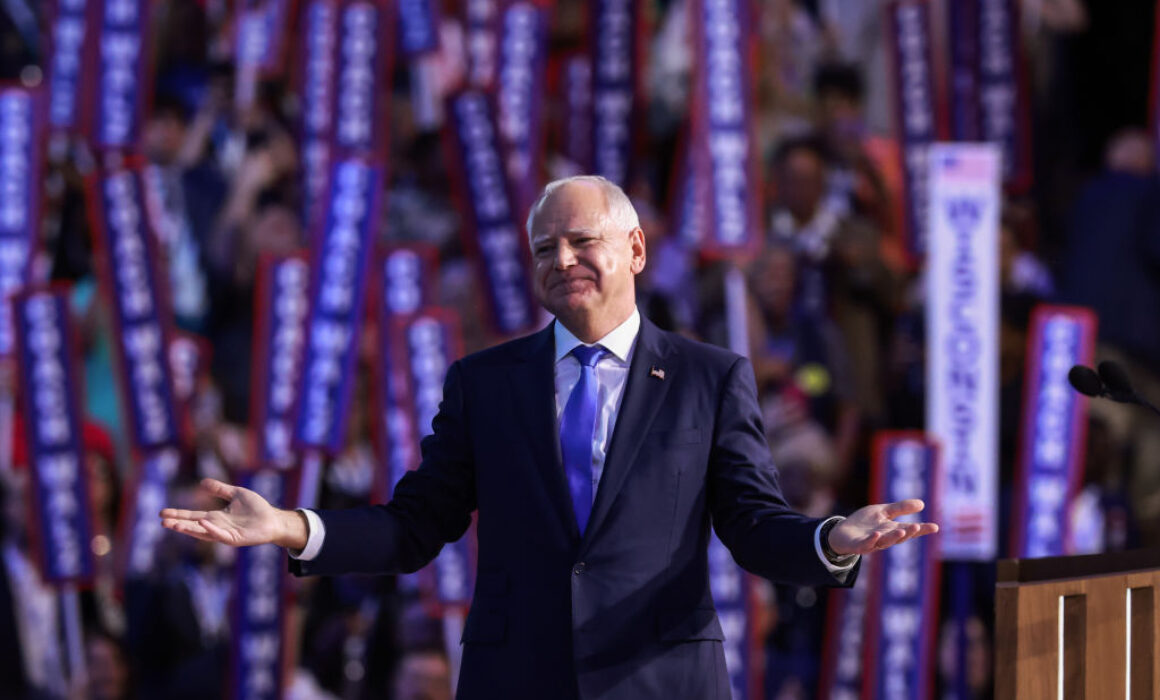What Coach Walz’s Minnesota Playbook Can Teach Us
August 29, 2024
By Suzanne Kahn
Fireside Stacks is a weekly newsletter from Roosevelt Forward about progressive politics, policy, and economics. We write on the latest with an eye toward the long game. We’re focused on building a new economy that centers economic security, shared prosperity, and rebalanced power.
(Photo by Getty Images)
Over the last four years, the Biden-Harris administration has made tremendous progress on many of the pressing crises facing our nation. But much remains to be done, especially for families who have long been struggling with the rising cost of living. As Vice President Kamala Harris said in her speech at the DNC, a top priority for her administration would be lowering the cost of everyday needs for families.
Topping that list of challenges are issues that Harris is deeply familiar with as a Californian: the cost and availability of housing, childcare, and energy. With decades of population growth and persistent challenges increasing supply of essential goods and services, California was among the first states to experience the affordability crisis that has now reached much of the country. Harris’s choice of running mate shows how her future administration might begin to address these problems. Governor Tim Walz—with the help of organizers and a Democratic legislature—has turned Minnesota into a model for progressive solutions to these exact crises.
To be clear, comparing California and Minnesota is a bit apples-to-oranges. If California were a country, it would have the fifth-largest economy in the world. Minnesota has the 20th-largest economy in the country. But as we think about policy approaches on the national stage, there are lessons to be learned from the experience of both states.
California is well-known as the most expensive state in the country. A variety of factors drive the high cost of living, but for years it has been fueled by the housing crisis. Californians pay the most expensive rents and face the most expensive home prices in the nation; the state also has one of the highest rates of people experiencing homelessness. These costs are driven in large part by a lack of supply—for decades, population growth has outpaced new housing construction. Despite a yearslong effort to address this crisis, in each of the last four years the state has only constructed half the new units it needs each year, according to one estimate.
California families have had to contend not only with high housing costs for years, but also high childcare costs. In fact, in most counties, childcare is the highest household expense. In 2017, the California Budget and Policy Center calculated that in a low-income California family with two parents and one infant, the parents would each have to work 147 hours a week to be able to keep childcare at only 7 percent of their income, as federal guidelines recommend. Here too, supply shortages are part of what keeps costs high. Care workers earn a median hourly wage of $18.47 in California, a wage that keeps the majority of them in the bottom quartile of California earners. Even with workers making this extremely low pay, families struggle to afford care, so raising wages to retain a stable worker force in the industry is a challenge. In the wake of the pandemic, the care workforce has become even less stable. California lost almost 18,000 licensed childcare spaces between 2019 and 2021.
The cost of electricity has also squeezed Californians’ budgets, nearly doubling over the last decade for many customers. California deregulated its energy market in the late 1990s, creating competitive markets for wholesale energy. Shortly thereafter, it faced a major energy crisis. In recent years, a new energy crisis has emerged as the deregulated utilities have been able to pass the costs of making necessary and vital investments, such as upgrading transmission infrastructure and mitigating wildfire risks, onto consumers.
Housing, care, and energy are essential and significant expenses underlying a broadly felt affordability crisis for families across the country. Notably, in Minnesota these expenses have started to come down thanks to the robust harnessing of public power to address these supply crises. Importantly, policymakers have not used the same strategy in each case. Rather, a nuanced analysis of where market failures are occurring has been paired with a willingness to use government funds to shape markets in the public interest. This approach offers a template for the rest of the country.
Take housing. In Minneapolis, between 2017 and 2022 housing stock increased by 12 percent, while population and rents grew by only 1 percent. During the same years, rents in the rest of Minnesota rose by 14 percent, while housing stock grew by 4 percent. Minneapolis’s experience was not an accident. Since 2009, the city has led the way in encouraging apartment construction by changing restrictive zoning laws, including in 2018 eliminating single-family zoning. In 2022, a court moved to stop Minneapolis’s plan, but the state legislature and Governor Walz passed legislation allowing it to move forward earlier this year. Statewide, Minnesota has also made significant investments in building out affordable housing infrastructure over the past few years—including investing $1 billion in housing in 2023, over half of which went to building out affordable housing supply. Beyond simply expanding housing supply, the state has substantially strengthened tenant protections.
In 2023, Minnesota also took on the cost of care through a number of important pieces of legislation. Governor Walz signed a paid family and medical leave bill—an essential part of care infrastructure—that gives workers 12 weeks of paid leave at 90 percent of their pay. This is one of the most generous paid leave programs in the country. That same year, Minnesota addressed the root causes of the supply crisis in childcare through direct investments: The state created a permanent fund to raise childcare workers’ pay modeled on the one deployed at the federal level during the pandemic. And, in each of the last two years, the state has also made major investments in childcare infrastructure expected to create over 2,000 new childcare slots each year.
Like other states with Democratic trifectas, Minnesota has also recently enacted ambitious climate legislation, intended to rapidly convert the state’s energy supply to green sources. Under Governor Walz, Minnesota has set a goal of halving the state’s climate emissions by 2030 and achieving carbon neutrality by 2050. California has a goal of achieving carbon neutrality by 2045 but is off track, as some emissions have actually increased in recent years. Minnesota, meanwhile, has made impressive progress on its goals—over half of its energy is now provided by zero-carbon sources, while consumer electricity prices remain below the national average.
But, fully meeting its emissions goals requires more action. Recognizing this, Governor Walz is requiring Minnesota utilities to provide 100 percent clean energy by 2040, a requirement that is being supported by strong legislation aimed at accelerating the build-out of clean energy infrastructure.1 A 2024 law consolidated the public approval process under its Public Utilities Commission, streamlining the process without eliminating opportunities for public comment and environmental review. It is estimated that the law will cut clean energy project timelines in half.
Minnesota has been able to make significant progress on the major line items in families’ budgets through creative and nuanced uses of public power. It has been willing to assert a stronger role for government planning to increase the supply, affordability, and quality of housing, childcare, and clean energy—three essential markets that challenge Americans’ budgets across the country. In some cases that has meant changing what the private sector is able to build quickly; in others it has meant direct investment. Across all three cases, Minnesota has seen remarkable early success.
No one knows the affordability challenges facing Americans better than Californians, and no state is better positioned to show the nation how to solve them than Minnesota. Harris’s biggest choice so far—her selection of a running mate—sends a signal that her administration will be one ready to deploy government power to bring down costs for all Americans.
1California has a similar Renewables Portfolio Standard, which requires 60 percent clean energy by 2030 and 100 percent by 2045.
If You Ask Eleanor
“[T]here has been so much experimentation in this field that there is plenty of experience to draw on to do some very effective work.”
– Eleanor Roosevelt, My Day (March 4, 1948)



